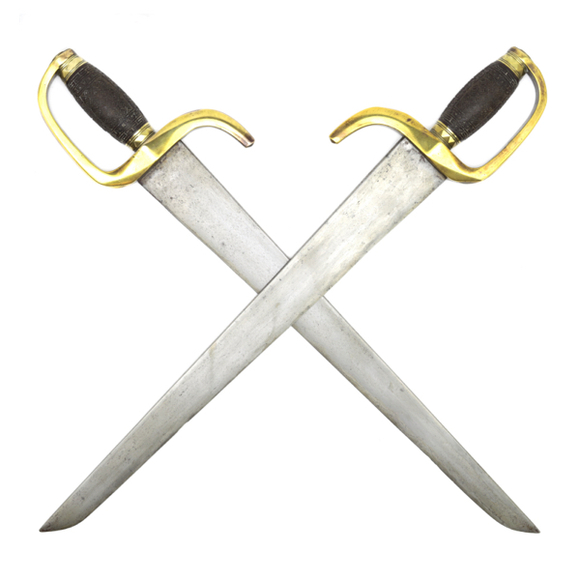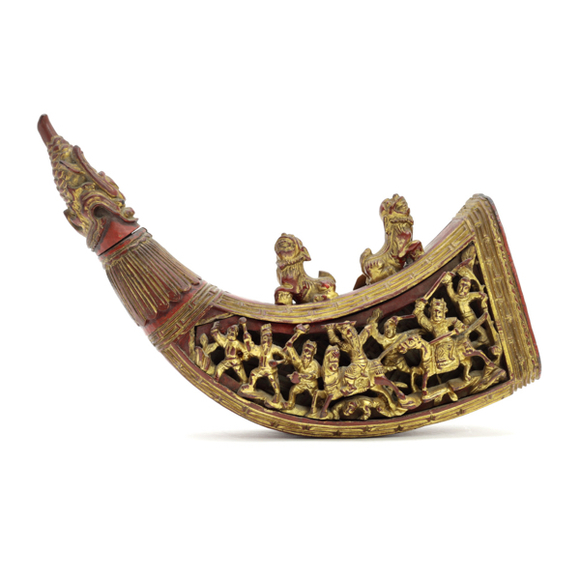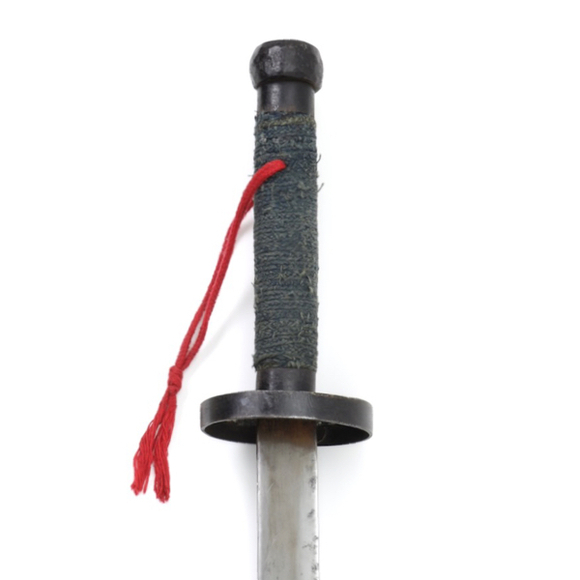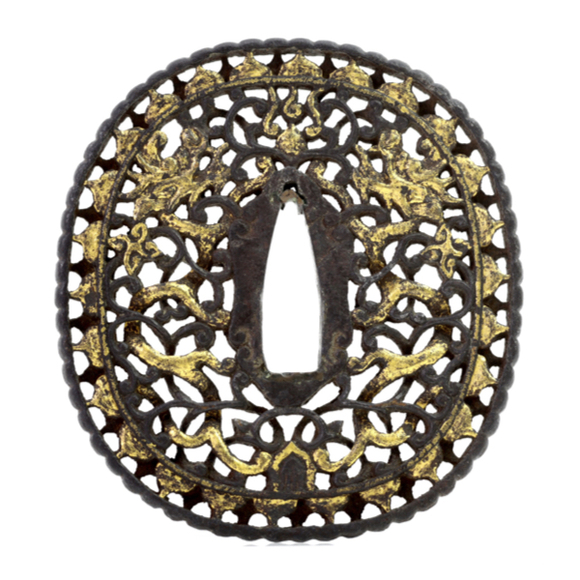Language: Mandarin Chinese
Source: Collector's / martial artist's jargon
Description
The húdiédāo (蝴蝶刀), are a type of double swords that seem to have originated in or around the port cities of southern China. The local Cantonese name is wu dip dou. They are also known in Cantonese as bat jam do (八斬刀) or "eight cutting knives", pronounced bāzhǎndāo in Mandarin.
Their defining feature is a large D-shaped guard with upturned quillon at the back, usually of a copper alloy but sometimes made of iron. They typically have half-hilts that fit in a single scabbard side-by-side and can be drawn as if they were one weapon. The blades are usually quite straight and with a fairly strong taper.
 A pair of húdiédāo seen from the back. Notice the handles that are flat to fit tightly together.
A pair of húdiédāo seen from the back. Notice the handles that are flat to fit tightly together.
In period sources
One of the earliest depictions of a húdiédāo was in the Illustrated London News of January 6, 1844, in an article titled Chinese Trophies at windsor Castle:

Illustrated London News. January 6, 1844. Page 8.
These weapons came from the steamer Nemesis, which under captain was involved in the first Anglo-Chinese war. It mainly saw action in the year 1841 where it was involved in the Second Battle of Chuenpi on 7 January, Battle of First Bar on 27 February, and the Broadway expedition on 13–15 March. All in Guangdong province.
An early textual reference of húdiédāo (蝴蝶刀) dates from 1842:
“March the 21st, Lin was busy drilling 3,000 troops, a third portion of which was to consist of double-sworded men. These twin swords, when in scabbard, appear as one thick clumsy weapon, about two feet in length; the guard for the hand continuing straight, rather beyond the “fort” of the sword turns toward the point, forming a hook about two inches long.
When in use, the thumb of each hand is passed under this hook, on which the sword hangs, until a twist of the wrist brings the grip within the grasp of the swordsman. Clashing and beating them together and cutting the air in every direction, accompanying the action with abuse, noisy shouts and hideous grimaces, these dread heroes advance, increasing their gesticulations and distortions of visage as they approach the enemy, when they expect the foe to become alarmed and fly before them.
Lin had great faith in the power of these men." 1
-Captain Bingham, 1842
"Narrative of the Expedition to China, from the Commencement of the Present Period." Volume 1.
Henry Colburn, London, 1842.
Varieties
Húdiédāo come in two main varieties. The most common among antiques the are long, thick but narrow blades with a subtle back bevel and sharp tip. They are generally of good quality and tend to differ very little from piece to piece which seems to indicate large-scale central production. The grips are usually of a precious hardwood, often carved with auspicious designs.
 The narrow variety.
The narrow variety.
Another common type has shorter, wider but thinner blades with clipped tips. This is the type that is most popular today among martial artists. Among these, there tends to be a lot less uniformity.

The wider variety.
Several other varieties exist, among which sets with curved blades with raised back-edges, and several variations that follow blades styles of southern ethnic minorities.
My understanding is that the heavy, narrow type is capable of delivering heavy cuts and deep thrusts, making it a lot more lethal, As such, it was more likely to have been used by local militia and the military who were allowed to kill in some circumstances. The wider, thinner version now popular under martial artists is much more suited for disabling the opponent while trying to avoid killing him. I think this explains their continued popularity into modern times.
Historical use
Although neither húdiédāo (蝴蝶刀) nor bāzhǎndāo (八斬刀) bazhandao turn up in classical literature, many units were listed that used shuāngdāo (雙刀), simply translated as "double swords" which could mean anything single-edged. These shuāngdāo, when illustrated, usually resemble the conventional Qing military saber, but used in pairs and with half-hilts to fit in a single scabbard.
The Qing military never completely standardized weapons across the empire and regional variations were allowed. It could be that húdiédāo (蝴蝶刀) were at some point simply the southern variation of shuāngdāo (雙刀), a weapon more adopted to combat in the confinement of ships with its D-shaped guards that double as knuckledusters.
A number of single, longer swords of identical shape have turned up with military markings attributing them to Green Standard Army units of Guangdong. I have one in my collection with markings attributing them to Green Standard Army units of Guangdong, in the 3rd year of Tongzhi, corresponding largely with our year 1863. Such single swords were usually used in conjunction with a rattan shield, as seen in period photographs.

Rattan shield troops carrying single, long húdiédāo.
London Illustrated News, 1900.
In the late 19th to early 20th century the húdiédāo was still used by gang members in for example San Francisco Chinatown.2

The weapons of Chinese gang members. Illustrated in Harper's Weekly of February 13, 1886.

Weapons confiscated at immigration, Washington D. C., circa 1900.
Photo in the Bancroft Library, UC Berkley.
For an in-depth article, see Ben Judkins; Tools of the Trade: The Use of Firearms and Traditional Weapons among the Tongs of San Francisco, 1877-1878. 2013.
Today
Today, húdiédāo are still used in a number of southern Chinese martial arts, including Wing Chun, Hung Gar and Choi Li Fut. It is notable that only the wider civilian variety has remained in widespread use.






